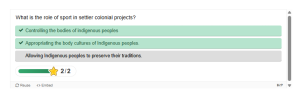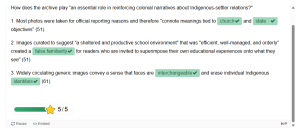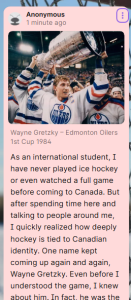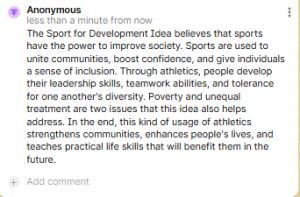4
These are difficult stories. We bear witness in this chapter to the role of sport in furthering the settler colonial projects throughout Turtle Island. Here are some supports to access in the community and from a distance:
First Peoples House of Learning Cultural Support & Counselling
Niijkiwendidaa Anishnaabekwag Services Circle (Counselling & Healing Services for Indigenous Women & their Families) – 1-800-663-2696
Nogojiwanong Friendship Centre (705) 775-0387
Peterborough Community Counselling Resource Centre: (705) 742-4258
Hope for Wellness – Indigenous help line (online chat also available) – 1-855-242-3310
LGBT Youthline: askus@youthline.ca or text (647)694-4275
National Indian Residential School Crisis Line – 1-866-925-4419
Talk4Healing (a culturally-grounded helpline for Indigenous women):1-855-5544-HEAL
Section One: History
A) The Residential School System
Exercise 1: Notebook Prompt
We are asked to honour these stories with open hearts and open minds.
Which part of the chapter stood out to you? What were your feelings as you read it? (50 words)
| What really stood out to me was how sports and music, which are usually fun and positive, were used to try and erase Indigenous culture. It made me feel really sad and confused. I honestly do not understand how anyone could believe that doing those things would make someone less Indigenous.
|
B) Keywords
Exercise 2: Notebook Prompt
Briefly define (point form is fine) one of the keywords in the padlet (may be one that you added yourself).
|
Sport for Development Ideology The Sport for Development Idea believes that sports have the power to improve society. Sports are used to unite communities, boost confidence, and give individuals a sense of inclusion. Through athletics, people develop their leadership skills, teamwork abilities, and tolerance for one another’s diversity. Poverty and unequal treatment are two issues that this idea also helps address. In the end, this kind of usage of athletics strengthens communities, enhances people’s lives, and teaches practical life skills that will benefit them in the future. |
C) Settler Colonialism
Exercise 3: Complete the Activities



Exercise 4: Notebook Prompt
Although we have discussed in this module how the colonial project sought to suppress Indigenous cultures, it is important to note that it also appropriates and adapts Indigenous cultures and “body movement practices” (75) as part of a larger endeavour to “make settlers Indigenous” (75).
What does this look like? (write 2 or 3 sentences)
|
The way newcomers appropriated Indigenous sports like shinny, lacrosse,etc while removing their traditional and spiritual significance is an example of this shift. As a part of colonial identity and survival, these customs were transformed into sports or outdoor pursuits and were not honored as Indigenous knowledge. To feel more connected to the land, settlers occasionally adopted ceremonies or dressed traditionally, although ignoring the hardships and uprooting of Indigenous people. It was a way to claim connection while continuing to push Indigenous voices and traditions to the side.
|
D) The Colonial Archive
Exercise 5: Complete the Activities

Section Two: Reconciliation
A) Reconciliation?
Exercise 6: Activity and Notebook Prompt
Visit the story called “The Skate” for an in-depth exploration of sport in the residential school system. At the bottom of the page you will see four questions to which you may respond by tweet, facebook message, or email:
How much freedom did you have to play as a child?
What values do we learn from different sports and games?
When residential staff took photos, what impression did they try to create?
Answer one of these questions (drawing on what you have learned in section one of this module or prior reading) and record it in your Notebook.
| I had a lot of freedom to play when I was growing up. My dad was the first person from our country to win a gold medal in an international rollerblading competition. He also owned one of the biggest skating clubs in the country, so I started rollerblading when I was six. From there, I played handball and got to travel and represent my country in places like Nepal, Sweden, and Denmark. Later, I also played football (soccer) and joined a club’s under 18 team, and even tried out for soccer at Trent University. Playing sports was a big part of my life, and I was always supported in it.
I have learned how to work hard, trust my teammates, and maintain my strength in the face of hardship thanks to sports. I learned the value of teamwork, respect, and focus from playing football and handball. I gained knowledge about how to encourage people, be patient, and get better with practice. Unfortunately, rather than fostering growth, sports were used to control children at residential schools. That has a significant impact. Playing because you are told to does not teach you the same thing as playing freely. When taking photos of children at residential schools, staff members frequently attempted to portray the children as happy and enjoying their time there. But these images did not capture the reality of existence. Many of the children were separated from their families and cultures and had to adhere to harsh restrictions. The purpose of the pictures was to present the schools in a positive light to outsiders, but the reality was quite different. The children’s suffering and unjust treatment were being kept hidden.
|
B) Redefining Sport
B) Sport as Medicine
Exercise 7: Notebook Prompt
Make note of the many ways sport is considered medicine by the people interviewed in this video.
| Several people in the video discussed how, in their life, sports serve as a kind of medicine. Aiden Baker referred to lacrosse as his “healing” since it helped him cope with his spiritual and emotional issues. Others claimed that, especially in residential schools, sports provided them with happy and liberating moments in difficult times. William talked about how, despite being removed from his family at a young age, boxing played an important part in his early years. Boxing provided him with strength and helped him deal with his experiences despite his fear and difficulties. Because sports like lacrosse are admired and have been used to preserve language and identity, they also helped individuals maintain a sense of cultural identity. Sports gave many people a feeling of purpose, pride, and confidence. It provided new opportunities and access to education. In general, people believe that sports inspire, heal, and unite people.
|
C) Sport For development
Exercise 7: Notebook Prompt
What does Waneek Horn-Miller mean when she says that the government is “trying but still approaching Indigenous sport development in a very colonial way”?
| Waneek Horn-Miller is saying that the government still fails to fully understand or value how Indigenous communities develop and maintain sport, despite attempts and funding promises. She notes that some gifted athletes reside in isolated places without access to facilities, coaching, or appropriate training. The government continues to use top-down strategies based on colonial ideas of sport rather than collaborating with Indigenous people to develop systems that reflect local reality and values. Indigenous athletes are frequently not supported by these structures in a way that honors their identity, links to the community, or cultural customs. Horn-Miller advocates for the growth of sport under the direction of Indigenous people, guided by their own needs and expertise, and based on mutual respect and collaboration. |
Exercise 8: Padlet Prompt
Add an image or brief comment reflecting some of “binding cultural symbols that constitute Canadian hockey discourse in Canada.” Record your responses in your Notebook as well.

As an international student, I have never played ice hockey or even watched a full game before coming to Canada. But after spending time here and talking to people around me, I quickly realized how deeply hockey is tied to Canadian identity. One name kept coming up again and again, Wayne Gretzky. Even before I understood the game, I knew about him. In fact, he was the only hockey player I could name, mostly because of the quote from The Office: “You miss 100 percent of the shots you don’t take – Wayne Gretzky – Michael Scott.” It was a funny scene but it the quote also stuck with me to take some leaps in life. Learning more about Gretzky, I found out he led the Edmonton Oilers to their first Stanley Cup in 1984, the picuture I used here, a moment that many Canadians remember with pride. That win was more than just a sports victory. It was something cultural, a piece of history. For many Canadians, hockey is not just a game. It is tied to emotion, national pride, and even personal identity.
|
Section Three: Decolonization
Please see the major assignment for this half of the term in the final section of this chapter.
Longer Prompt (5%):
TRC’s Call to Action 91
Call to Action 91 calls upon the government that Indigenous peoples should be respected and involved in all aspects of organizing and competing in major athletic events, such as the Olympics, Pan Am Games, and Commonwealth Games. The call is about more than just inviting Indigenous people to attend. It means involving Indigenous communities in planning, respecting territorial laws, and making sure their culture and voices are part of the event from the start. There has been some progress like this Call to Action is now part of the materials that Sport Canada sends to organizations who bid on or host major athletic events. In order to ensure that this is a part of a national strategy, they are also collaborating with provinces, territories, and other partners.
Also, the money for this effort has come from the Canadian government. They committed $18.9 million over five years in Budget 2017 and promised to continue funding every four years to promote culturally appropriate programming and Indigenous sport leadership. Contributions to the North American Indigenous Games, which unite Indigenous athletes from all around the continent, are part of this. Increased Indigenous pride and presence in sport is facilitated by hosting this. Canada is also supporting Indigenous involvement through events like the Arctic Winter Games and the Canada Summer Games. In 2025, the Summer Games will add lacrosse, a traditional Indigenous sport, to the official program. There are also discussions between Canadian Heritage and Indigenous groups about how Indigenous people can be part of the 2026 FIFA Men’s World Cup. Sport Canada is working with provinces and territories to set clear goals and expectations so that every hosting group across Canada knows how to include Indigenous people properly.
These are good but there is still more to do, Communities and individuals can help by supporting Indigenous groups in their area, learning about territorial protocols, and making space for Indigenous leadership. Schools, cities, and sports organizations can build relationships with local Indigenous communities early in their planning. Call to Action 91, tells us that reconcilation is not only through words but with actions too.


